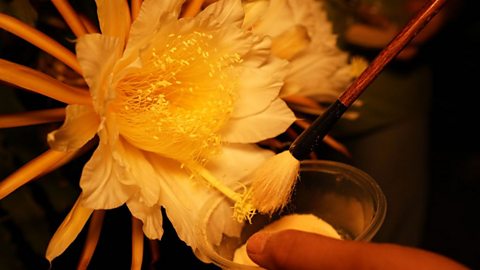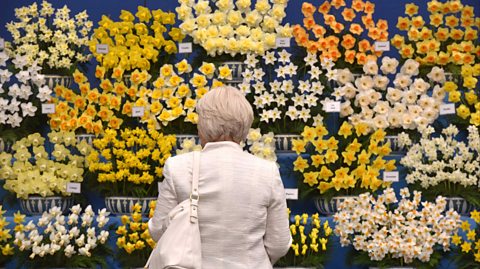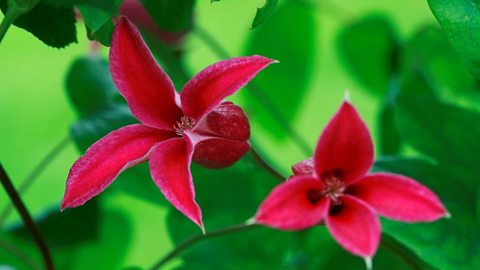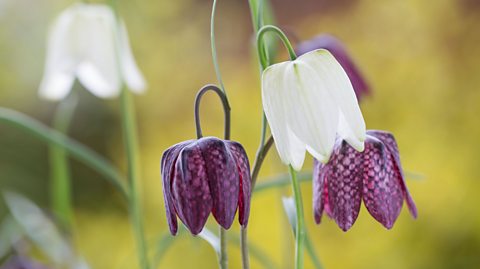Every year, new flowers are debuted at flower shows across the world.
They come in brand new colours, shapes and sizes, and are frequently named after famous people. But making a new flower is a slow art.
Bitesize spoke to Guy Barter, chief horticulturist at the Royal Horticultural Society (RHS) to understand how two flowers can be crossed together to create something stunning and new.
 Image source, VCG
Image source, VCGCreating a new flower isnтt easy
Making a new flower takes a lot of patience and itтs a process almost always done by hand.
Guy says: тIt is very laborious. Iтve done this for cauliflowers, sitting on a little stool in a hot greenhouse with a magnifying glass and a pair of tweezers.т
The plant breeder has to pick up the ттThe structure produced in the anthers of a flower that contains the male gamete (sex cell). from one plant, and transfer it to the second plant, using something like a cotton bud. If a breeder wishes to cross two plants that donтt normally flower at the same time, the pollen from one plant has to be kept in deep freeze storage until the other plant comes into flower. To protect against pollinating bees, the plant may be covered by a fabric bag.
Once the pollination is complete, the waiting begins. Guy estimates that тit takes 10 years to raise new plants, much more if new woody plants are being bred т 25 years for fruit trees, for example.т
A new camellia that made its debut at the RHS Chelsea Flower Show 2021, has taken 20 years to breed, and is a cross between spring and summer blooming varieties.
The new hybrid plants are observed to see which crosses are producing plants with the desired characteristics, in a stable way. This means that any offspring that come from the hybrid plant must also consistently produce the same characteristics. Itтs a process which happens over several generations of plants. Only once a plant is stable can it be multiplied, put on garden centre shelves and sold.
While this is certainly a time-consuming process, itтs not put off some amateur enthusiasts trying to create their own hybrid plants at home. If theyтre able to get a completely new and stable plant, which hasnтt been patented by someone else, these gardeners can sell their plants to garden centres, who then develop them into something saleable.
Guy highlights: тSome of these sink with no trace and others can sell well, and may provide their breeder with revenue.т
 Image source, VCG
Image source, VCG Image source, ТщЖЙдМХФ
Image source, ТщЖЙдМХФThe science behind creating the right flower
For most plant breeders, cross-breeding is a case of trial and error. They will make thousands of crosses and then wait to see what the seedlings do.
Guy explains: тSo if it's a carrot, you wait for it to produce a root. If it's a rose, it's got to produce woody stems and flowers, and that could be several years. So you can see that rose breeding requires a big field with lots of large plants for several years, all carefully labelled.т
Large breeding companies with access to advanced laboratories are able to investigate the genetics of each plant and look for certain markers.
тIf youтre breeding a lettuce and you want it to be resistant to an Small insects that suck sap from plants, which causes damage. , or to A plant disease which occurs in wet weather conditions and is caused by a fungus-like organism., you can look for the A small section of DNA that gives a characteristic. that code for those properties. You take your thousands of seedlings and you test each one for those markers and the ones that havenтt got it are discarded.т
Guy also highlights that it can be easier to cross-breed plants of the same species. It is possible to cross-breed different species of plant to create new colours, but it requires a lot more crosses to do so, and that means more time.

 Image source, REDA&CO
Image source, REDA&COFlowers named after famous people
- Queen Elizabeth (Rose)
- Dame Judi Dench (Rose)
- Princess Diana (Clematis)
- Audrey Hepburn (Rose)
- Amadeus Mozart (Rose)
- Judy Garland (Rose)
- Tina Turner (Rose)
- Barbra Streisand (Rose)
- Yves St. Laurent (Rose)
- William Shakespeare (Rose)
- Dame Darcey Bussell (Rose)
 Image source, REDA&CO
Image source, REDA&CO
Getting a flower named after you
You might have heard stories of flowers being named after noteworthy people. In reality, the process of creating that flower started many years before it was ever linked to someone.
There is a huge demand for roses in particular, which leads to high prices. Guy explains that a professional breeder is likely to charge tens of thousands of pounds for the right to name their flower. Amateur breeders will do it for a lot less money, but the resulting rose isnтt likely to stay in cultivation for long.
In some cases however, a plant breeder will choose to honour someone for free. In 2021, a new rose entered the market and to mark the pandemic and the efforts of healthcare workers, it was named after the founder of the NHS, Nye Bevan.
For anyone who is keen to get a flower named, Guy recommends that you approach breeders of plants like fuchsias or dahlias: тYou've got a much greater chance and much lower cost of being able to find something that's good.т
Five flowers that made history
Flowers are used to mark life milestones, but their importance sometimes goes beyond personal stories.

From flowers protected in a secret location, to those who тtrickт bees, we look at six wildflowers that are endangered in the UK.

Quiz: Do you have houseplant power?
From spider to Swiss cheese, we test your knowledge on your plant babies.
